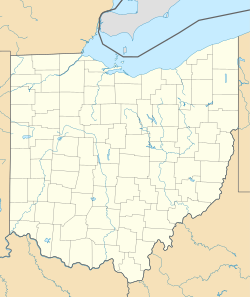St. Mary's on the Flats
| St. Mary's on the Flats | |
|---|---|
| Church of Our Lady of the Lake | |

St. Mary's on the Flats
|
|
| 41°29′24″N 81°42′01″W / 41.49002°N 81.70030°WCoordinates: 41°29′24″N 81°42′01″W / 41.49002°N 81.70030°W | |
| Location | Cleveland, Ohio |
| Country | United States |
| Denomination | Roman Catholic Church |
| History | |
| Dedication | Our Lady Of The Lake |
| Dedicated | June 7, 1840 |
| Past bishop(s) |
John Baptist Purcell of Cincinnati, Louis Amadeus Rappe, Richard Gilmour |
| Architecture | |
| Status | Parish church |
| Functional status | Demolished |
| Architect(s) | Golden |
| Architectural type | Church |
| Groundbreaking | 1838 |
| Completed | 1840 |
| Construction cost | $3,000 |
| Closed | January 6, 1886 |
| Demolished | September 1888 |
| Specifications | |
| Length | 81 ft (25 m) |
| Width | 53 ft (16 m) |
| Number of floors | 1 |
| Floor area | 4,290 sq ft (399 m2) |
| Number of spires | 1 |
| Materials | Wood |
| Administration | |
| Diocese | Cleveland |
| Province | Cincinnati |
St. Mary's on the Flats, originally known as the Church of Our Lady of the Lake, was the first Catholic church building in Cleveland, Ohio. The location where the church once stood can be found, in an 1881 atlas, at the south-east corner of Columbus Ave. and then Girard Ave. on the east bank of the Cuyahoga river in the flats. Irishtown Bend Archeological District, where many of the parishioners lived, lies to the west, across the Cuyahoga river in what was Ohio City. Ohio City was annexed by Cleveland on June 5, 1854.
Malaria was common in the area the church was built, but drainage was improved during the 1830s as Cleveland evolved into a major lake shipping port. The 1830s and 1840s brought continued prosperity to the port of Cleveland, but communicable diseases such as cholera were widespread in the low-lying Flats. As a result, low cost land was available for housing the workers who walked to the jobs on the docks.
The number of Irish immigrants increased after the 1848 Irish potato famine, and many worked as unskilled laborers and dockworkers, and on the excavation of a new channel and mouth for the Cuyahoga River. In the 1850s, the area of Irishtown Bend was established and dominated by the winding Cuyahoga River with its swampy flood plain. Houses were primarily one or two stories and built of wood.
As the second generation of Irish families obtained better-paying work, and dock work was increasingly mechanized, the Irish began moving out of the Flats. By 1900, more than half of this area's residents were of Eastern European origin. Irishtown Bend was gradually abandoned.
Early accounts of the parish depend on tradition and have few verifiable dates and facts. Prior to 1878, only a few parishes kept historical records and there was no uniform method or system for the keeping of historical records in the Roman Catholic Diocese of Cleveland.
On June 19, 1821, the Diocese of Cincinnati was erected by Pope Pius VII from territory, including the entire state of Ohio, taken from the former Diocese of Bardstown. During this period, diocesan priests began to replace visiting missionaries; Dominican priests (1817–1842), Redemptorist priests (1834–1842), and Sanguinist priests (1844– ?).
...
Wikipedia

